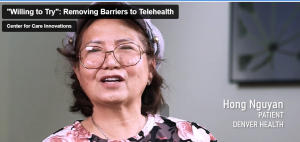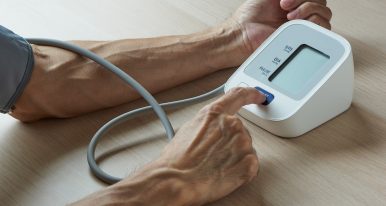During the pandemic, Maria Casaverde Marin noticed a disparity in virtual care among the non-English speaking patients at Denver Health. The health hub serves 175,000 patients, but among the 33 percent of its patients who spoke a language other than English, telehealth visits were disproportionately low. “I started thinking, ‘Why is this happening?’” said Maria Casaverde Marin, MHA, a quality improvement operations coordinator at Denver Health. With the help of a grant from the Center for Care Innovations (CCI), she began looking into the barriers that their non-English-speaking patients were facing.
CCI’s short video “‘Willing To Try’: Removing Barriers to Health Care” (see above) traces Denver Health’s ongoing journey to equitable telehealth care. Casaverde Marin and colleagues did a survey to find out how to improve telehealth for their non-English speaking patients. They found, to their surprise, that although all their instructions for telehealth visits were for desktop computers, most of their patients used only mobile phones. In addition, the instructions were in English, which they could not read. “When we got the findings, we realized, “‘Oh, wow, nothing we have created matches what our patients need,’” Casaverde Marin reported. “You’re like, ‘How did we miss this?!’”

The health hub turned the numbers around by hiring bilingual patient navigators in all their primary care clinics, beginning with their top three non-English languages: Spanish, Arabic, and Vietnamese. “When a patient comes in with no English, it’s scary — it’s very scary,” patient navigator Joseph Dang told the filmmakers. Patient Hong Nguyan agrees. “When I come in and see there are no Vietnamese people, I feel so lost,” she confided to Dang in Vietnamese. But now, with Dang and other skilled guides trusted by the community, she and her fellow patients are more eager to set up telehealth appointments. The clinic also offers instructions on telehealth in different languages for smartphones, computers and tablets, as well as interpreters for the visits if needed.
In addition, the clinic strives to create culturally sensitive materials rather than rote, word-by-word translations. “We wanted to ‘trans-create’ the material in order to be culturally competent,” said Denver patient navigator Elizabeth Medina. “We want patients to feel understood, to feel valued, and to feel that we are aware of their culture [and value it].”
The video was created by Beth Freeman and team for the Center for Care Innovations and Kaiser Permanente, which funded the project in Denver as part of CCI’s Virtual Care Innovations Network, a virtual health collaboration founded by Kaiser Permanente.




